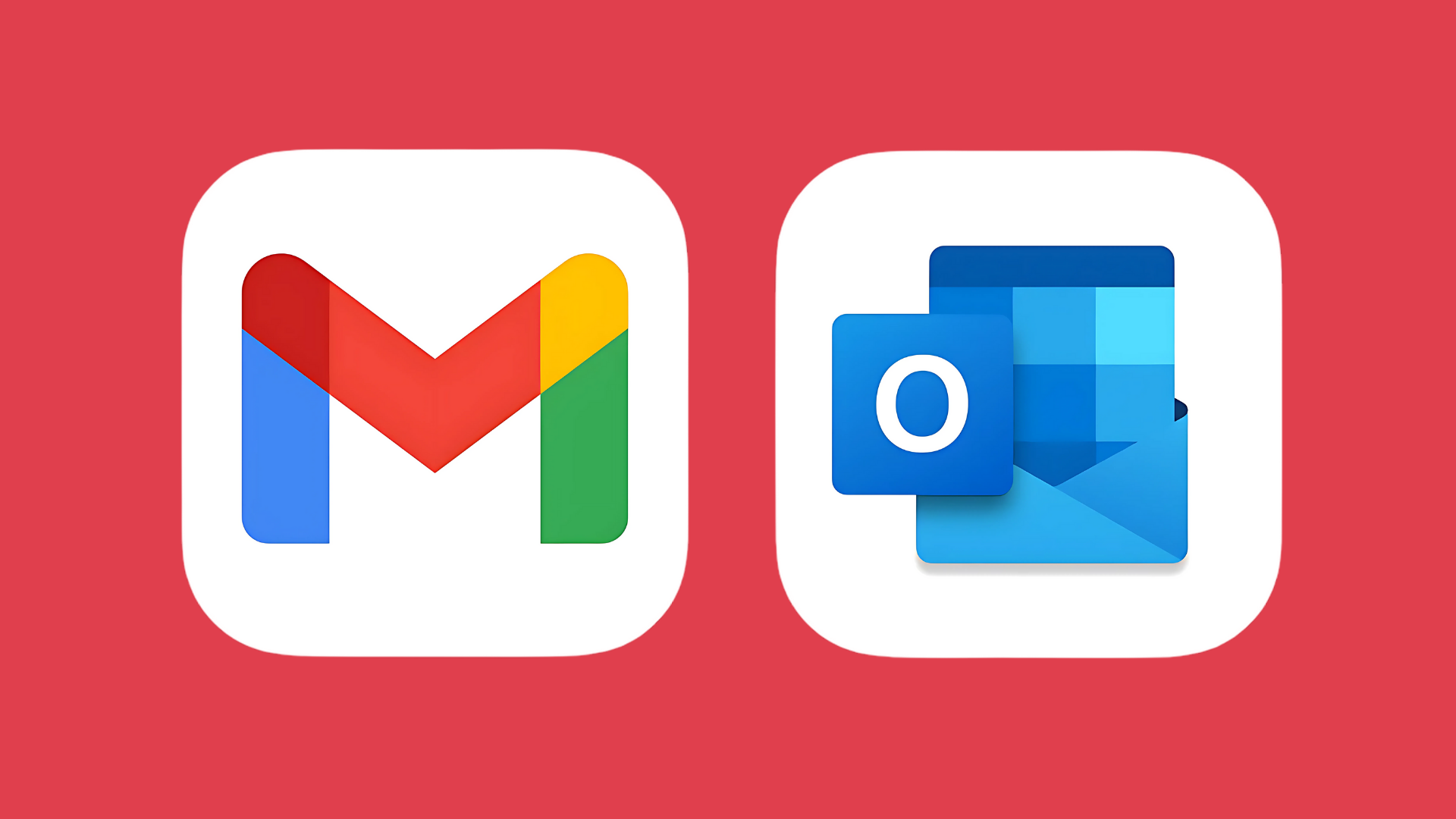Outlook vs Gmail: Which is best in 2024?
When looking to create a free email address with Outlook or Gmail, we've got a few tips to help you choose the best provider for top privacy and security.
This guide will help you decide whether it is better to use the free version of Outlook or Gmail. And if you decide that neither tick the boxes, we have an even better solution for all your email needs – particularly when security and privacy is important to you!
One of the first deciding factors, particularly for free users, is the new email address that you are going to create: Do you want your newly created email address to end in outlook.com or gmail.com? Alternatively, we’ve got a great third option in stock for you: Tuta Mail. As a new email provider focusing on security and privacy, it’s highly likely that your preferred email address is still available at Tuta, while this is most likely not the case for mainstream services like Gmail and Outlook.
Gmail vs Outlook free versions summarized
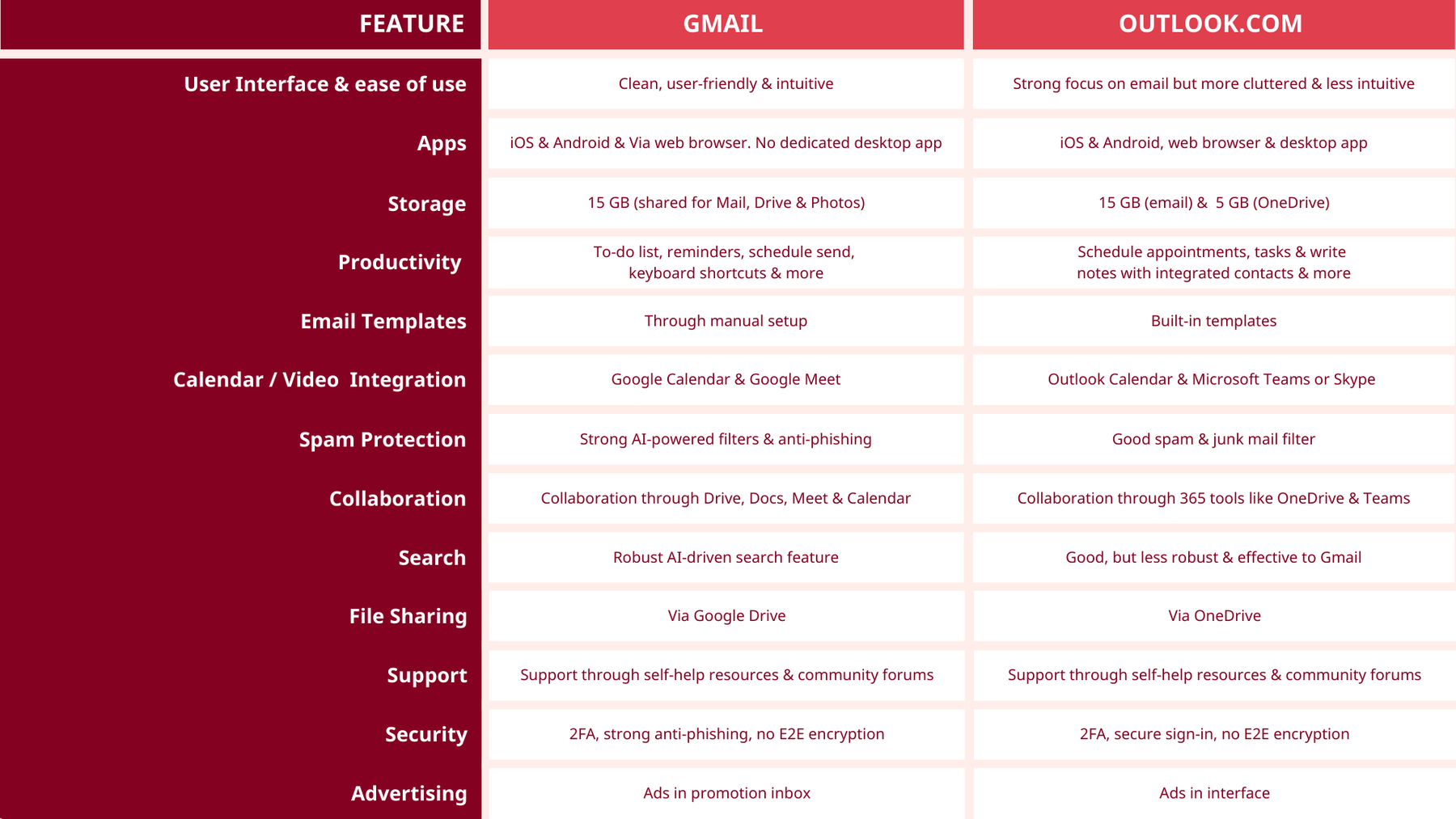

Gmail in Review
Google’s Gmail has been the go-to free email provider ever since it was released in 2004, and today it’s the most widely used email provider globally with more than 1.5 billion users. Since its release, it has been a top competitor in the email field and a key player when creating modern, new features. Gmail is also an email service that is user-friendly and has lots of features for organizing the inbox and for keeping it free from spam.
For personal use of Gmail, you can get a free Gmail account with 15 GB of free storage, great organizational tools, and access to Gmail’s robust search function. Gmail is best used via a web browser or the Gmail app on a mobile device. Unfortunately, when you use a free account, your email address will end in @gmail.com and your mailbox will come with Gmail’s invasive ads.
Outlook in Review
Microsoft owned Outlook (Hotmail) is the biggest email competitor to Gmail, and provider to over 400 million active users around the world. Like Gmail, Outlook offers a free email service (often referred to as Outlook.com or Outlook on the Web) that comes with 15 GB of free storage, essential organization tools, and some integration with Microsoft’s services like Office, OneDrive, or Skype. With free Outlook mail, you get an email address that ends with @outlook.com or @hotmail.com, and like Gmail, the interface also comes with ads.
What are the pros and cons of Gmail and Outlook?
There are many factors to consider when trying to decide which email provider is best for you to create a free email account with – and knowing the differences in features and tools can be challenging since there are so many. To help you, we’ve put together a summary of the pros and cons of Gmail and Outlook.
In summary, Gmail only provides email support while Outlook offers phone support in addition to email. However, with both providers these options are reserved for paying users. There is no support for users of the free version of Gmail or Outlook. Both offer a lot of storage for free, but Gmail also has ample features for free while Outlook is more limited to make you choose a paid subscription. Overall Gmail is more user-friendly whereas Outlook offers most customization options.
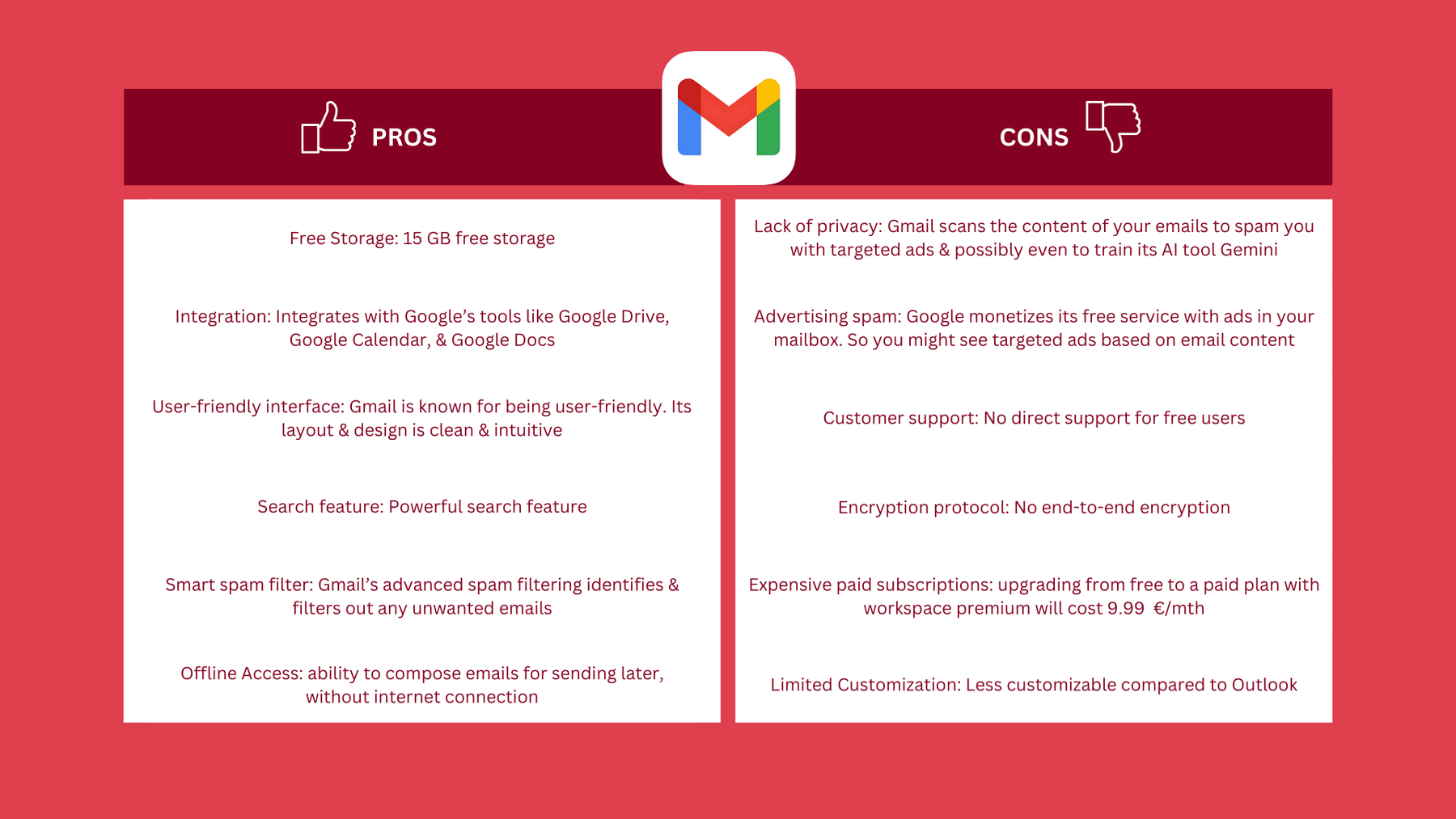

For personal use Gmail is a good solution if you’re looking for an email provider that has good features, ample storage, and an intuitive user interface. If you’re concerned about your data and privacy and do not want ads in your mailbox, then it may not be the best option.
The pros of Gmail:
- Free storage: All users get a free 15 GB storage that is shared between email, Google Drive and Photos.
- Integration: Gmail integrates easily with all Google’s tools like: Google Drive, Google Calendar, and Google Docs.
- User-friendly interface: Gmail is known for being user-friendly. Its layout and design are clean and intuitive.
- Search feature: Gmail has a powerful search feature that allows you to find emails fast.
- Clever spam filtering: Gmail’s advanced spam filtering identifies and filters out any unwanted emails.
- Offline Access: Users can view and compose emails without an internet connection for sending them later.
The cons of Gmail:
- Lack of privacy: Gmail scans the content of your emails to spam you with targeted ads and possibly even lets its AI tool: Gemini have access to your email data.
- Advertising spam: Because you don’t need to pay for the service, Google monetizes its free service with ads. So the interface is spammed with ads that are intrusive and distracting.
- Customer support: No direct support for free users.
- Encryption protocol: No end-to-end encryption.
- Expensive paid subscriptions: Gmail offers a free plan suitable for personal use, but if you want to get more features, like Google Workspace premium you will need to pay 9.99 €/mth.
If you’re not convinced that Gmail is the correct email provider for you, particularly as you might be looking for a service free of any ads, check out how Gmail compares to Tuta Mail – the best Gmail alternative.
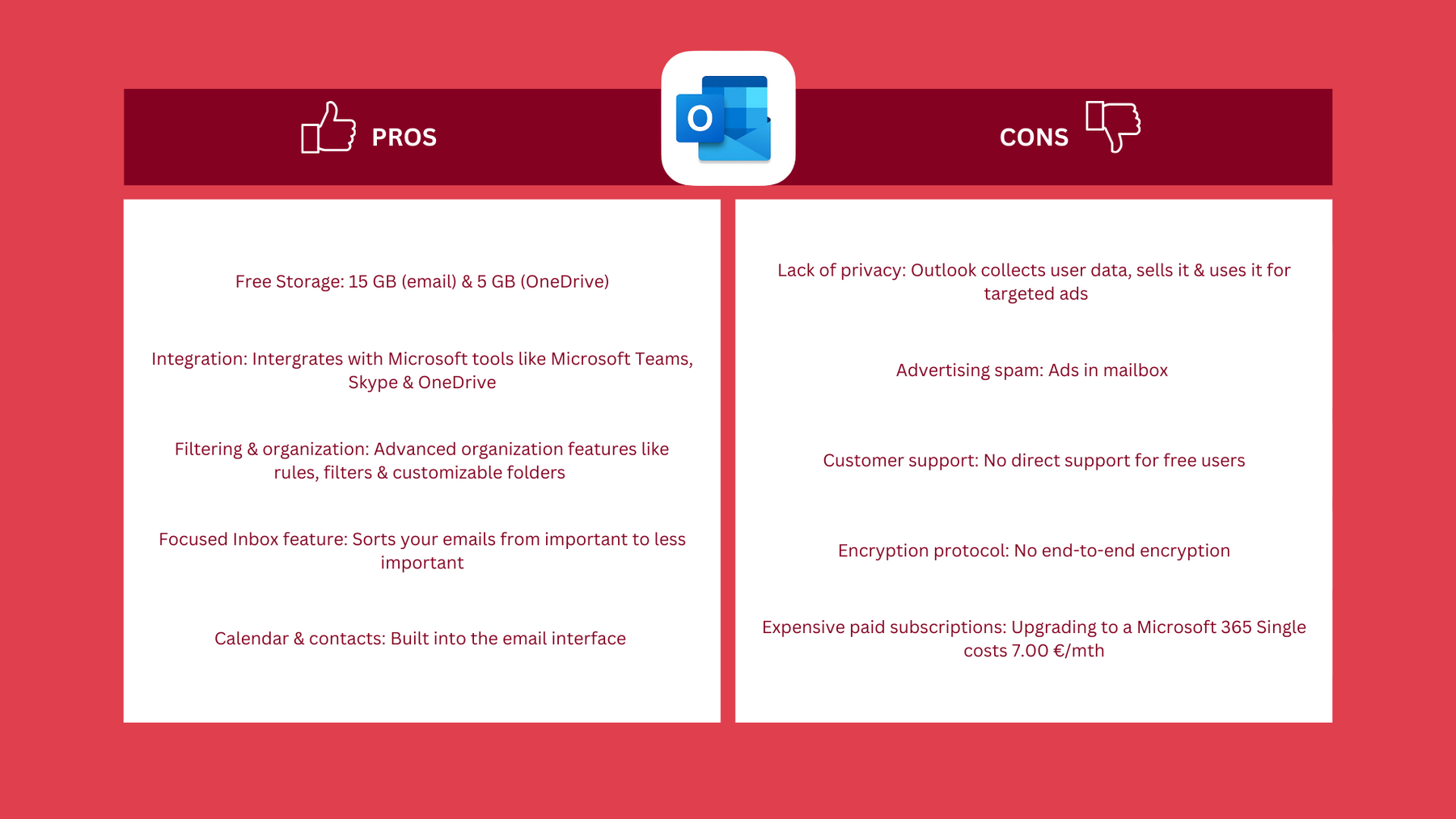

Outlook.com or Hotmail is a decent email provider for personal use: it has good organization features, storage, and integration with other Microsoft tools. A major downfall to using this provider, like with Gmail is the targeted ads in your mailbox and a lack of privacy.
The Pros of Outlook:
- Free storage: Outlook users using a free email account, also get 15 GB of free storage dedicated to email and additional storage for OneDrive.
- Integration with Microsoft Office Suite: Outlook integrates effortlessly with Microsoft applications like Word, Excel and PowerPoint making it easy to use and productivity-orientated.
- Advanced filtering and organization settings: Outlook has useful settings for organizing emails, this includes rules, filters, and creating customizable folders.
- Focused Inbox feature: This feature sorts your emails from important to less important.
- Calendar and contacts: Built into the email interface.
The cons of Outlook:
- Ad Spam: With free Outlook, a major con is a large amount of advertising spam in the interface. If you decide to use Outlook, we’d recommend to use a private browser with support for ad-blockers.
- Privacy: Like Gmail, Outlook collects user data, sells it, and uses it for targeted ads.
- Customer support: No direct support for free users.
- Encryption protocol: No end-to-end encryption in free plans.
- Expensive paid subscriptions: If you want to use more of Microsoft’s tools, get technical support and no advertising you will need to upgrade to a Microsoft 365 Single which costs 7.00 €/mth.
Outlook does have great organizational features and tools but this comes with an expensive subscription fee along with a loss of privacy. There are many Outlook alternatives like Tuta Mail that offer a free email account that’s fully encrypted with zero tracking and zero ads!
Differences of Outlook vs Gmail
Ease of use and interface design
Both Gmail and Outlook offer good interfaces, are intuitive and user-friendly, but each with their own tweaks and differences. Keep reading as we explore how Gmail’s and Outlook’s user experience compare.
Outlook
Outlook’s left-hand navigation panel which displays categories, folders, and some useful widgets makes the interface feel well laid out as it takes a more traditional email organization approach. While it does have a well laid out feel that’s intuitive, at the same time it somehow all feels a bit outdated and cluttered - especially comparing it to Gmail.
Gmail
On the other hand, Gmail’s interface is clean, simple, and easy to navigate. Gmail’s design can be customized and Google has made use of recognizable icons and eliminated all unnecessary text. Gmail feels more modern, clean, and easy to navigate.
Is it customizable?
Outlook
If you want to customize your mailbox, we’d recommend Outlook. Outlook has a good range of customization options so that you can make it look and work perfectly for you. Microsoft lets you customize your mailbox theme, font size, and colour scheme among others.
Gmail
On the other hand, Gmail doesn’t offer as many customization options – you can apply different preset themes to personalize the look, but this is less than what Outlook offers. Rather than giving the option to customize your mailbox, Gmail takes a more straightforward approach which allows for easy navigation within your inbox.
Mobile app features and usability
Gmail and Outlook both have great mobile apps for Android and iOS allowing you to easily send and receive emails on the move with convenience no matter if you are an Android or iPhone user. In terms of their mobile apps, each offers very similar features to the desktop versions.
Search functions
Gmail is well known for its powerful search tools, and Google’s search algorithms make it effortless to find specific emails and attachments fast. Outlook has a robust search feature with some basic filter options, but it’s not as quick and intuitive as Gmail’s search tool.
What about support?
If you get stuck when setting up your new email account, it’s only fair that you would like to get support from the provider. Both Gmail and Outlook lock direct support behind a paywall, so for free Outlook.com or Gmail plans support is not available. Both email providers offer support through self-help resources and community forums.
If you choose a paid plan of either Microsoft 365 or Google Workspace, you will have access to 24/7 support via email, phone or chat.
Features and functionality
You will find all the essential functions you need with Gmail and Outlook, but the email services do differ in terms of their advanced features. For some users, advanced features are not necessary, but if you are keen on boosting productivity, security, and email management then these advanced features are what you need to prioritize and take a closer look at how they compare in Outlook and Gmail.
Collaboration
Outlook
Outlook is heavily focused on email but the free version still has some integration with Microsoft 365. Outlook.com users can also use collaboration features like Microsoft Teams and OneDrive, among others. These 365 tools allow you to collaborate, share files, and join meetings via video chat.
Gmail
Gmail’s free version integrates into Google Workspace, so you can use tools like the Google Drive, Docs, Meet, and Calendar. These collaboration features allow you to work on documents in real-time with multiple people. Let you share files via Google Drive, and schedule and meet via video call all in one place.
Productivity
Outlook
Outlook has a range of super useful productivity features – users can manage and schedule appointments, tasks, and notes all in the same interface. Another great feature is the integrated calendar and contact list. For users who prioritize productivity or employees in the workplace, these features make scheduling appointments and managing meetings super convenient.
Gmail
Gmail offers an integrated to-do list with reminders, an option to snooze emails, schedule send, and keyboard shortcuts which are all designed to save you time. With the Google apps menu, users can also navigate the Google Calendar and quickly set up meetings or manage contacts in just a few clicks. Google’s Workspace also integrates super easily with Gmail, so all of Google’s tools are within reach of your mailbox to help boost productivity.
Security
Both email providers have good security features like spam filtering, virus scanning, two-factor authentication, message encryption, data loss prevention and advanced threat protection. While Gmail and Outlook offer these security features, it’s worth noting that both Gmail and Outlook do not offer end-to-end encryption by default which means that your private emails are more vulnerable to being accessed by unauthorized parties.
Unfortunately, Sending secure emails in Outlook with end-to-end encryption is only possible for paying users. If you’d prefer a mail provider that offers end-to-end encryption by default, even for free plans, we’d recommend Tuta Mail.
Attachment options and storage
Outlook
Outlook allows you to attach files up to 34MB in size which is a bit more than Gmail. Similar to Gmail, if your attachment is bigger than this, you can simply upload it into OneDrive and share a link to the file. Outlook.com users get 15 GB of dedicated email storage and an additional 5GB of free cloud storage for OneDrive.
Gmail
Gmail lets you attach documents up to 25MB in size and if you try upload a file that’s bigger than that it automatically uploads the file into Google Drive. From there you can share a link to the file in Google Drive with the email recipient. With free Gmail accounts users get 15 GB of storage that is shared across Gmail, Google Drive and Google Photos.
Management and organization
Outlook
One feature people love about Outlook is its rules and filters for incoming emails. With Outlook you can make rules and filters for emails so that as they arrive they are organized into folders prioritized based on importance. Creating rules for emails to be sent to their dedicated folders along with the advanced search capabilities means you can really organize your mailbox neatly to your liking – and avoid seeing any unnecessary mail.
Gmail
On the other hand, Gmail has label categories that are easy to use and take a more simple organization approach. One really useful organizational feature from Gmail is that they automatically categorize your emails into different tabs like ‘promotions’ or ‘social’ so that you don’t get spammed with promotional ad-emails in your primary mailbox. Despite this user-friendly approach, however, Google itself displays annoying ads into your Gmail client.
Automation and email templates
Outlook
Outlook allows you to manually create your own built-in templates, called Quick Parts which you can use in the web version.Free Outlook users can also make use of some limited automation features from Microsoft Power Automate.
Gmail
Gmail offers automated responses which are okay if you’re out of office or want an automated quick reply, but more advanced automation tools are limited. It also has built-in templates, called Canned Responses which you can manually set up and use for commonly used texts.
Gmail vs Outlook: Pricing and plans
Pricing and plans for Personal use:
Both Gmail and Outlook offer free email accounts for users and each gives you a good taste of what each paid suite entails. But with both email providers, if you’d like to take advantage and use all their features and tools, you need to subscribe for a paid account.
With Outlook’s free email, you get all the basic email features and 15 GB of free storage space when you create a new email address, but you don’t get the more advanced features like calendar integration, email organization, and contact management. Outlook mail is available on your web browser, whereas a paid subscription gets you access to the downloadable Microsoft 365 which has the full range of apps that integrate with Outlook mail.
If you decide to get a paid premium version of Microsoft 365, you gain access to the Outlook Desktop app and then you can take advantage of all the advanced features, collaboration tools, extra storage, and added security features. The most basic paid plan: Microsoft 365 Basic costs 2.00 €/mth but if you’d like to make the most of Microsoft’s tools we’d recommend the Microsoft 365 Single which costs 7.00 €/mth and includes 1 TB of cloud storage space, multiple device login, and ad-free emails among other benefits. But be aware of Microsoft’s pricing strategy that includes regular price increases.
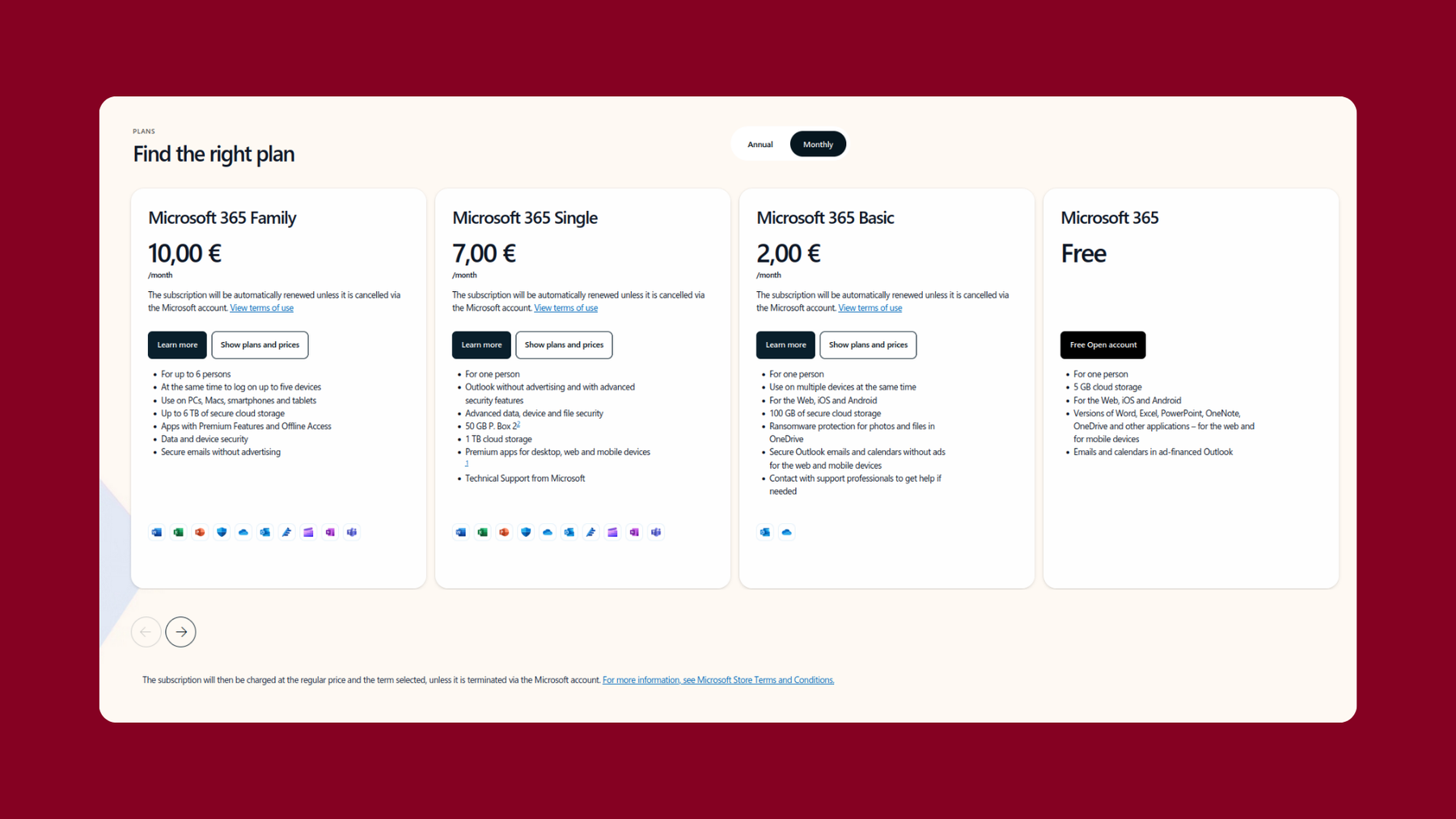

Outlook offers free email, but if you’re in need of more cloud storage space, dedicated support with professionals, or no ads the basic plan for one starts at 2.00 €/mth. If you’d like to make use of Microsoft’s more advanced tools, features, advanced security and premium apps you will need to pay 7.00 €/mth for the 365 Single plan.
When you create a free Gmail account for personal use it offers ample storage space of 15 GB, good organizational features, and a powerful search function. This free 15 GB storage is shared across your Gmail, Google Drive, and Google Photos. For many people, this free version is sufficient for personal use. If you’re in need of more advanced email tools and features, you have the choice to get a Google One account, which has different plans like the Basic plan for 1.99 €/mth and includes 100 GB and access to more Google One features or the Premium Plan for 9.99 €/mth. This includes 2 TB storage and access to all Google One features.
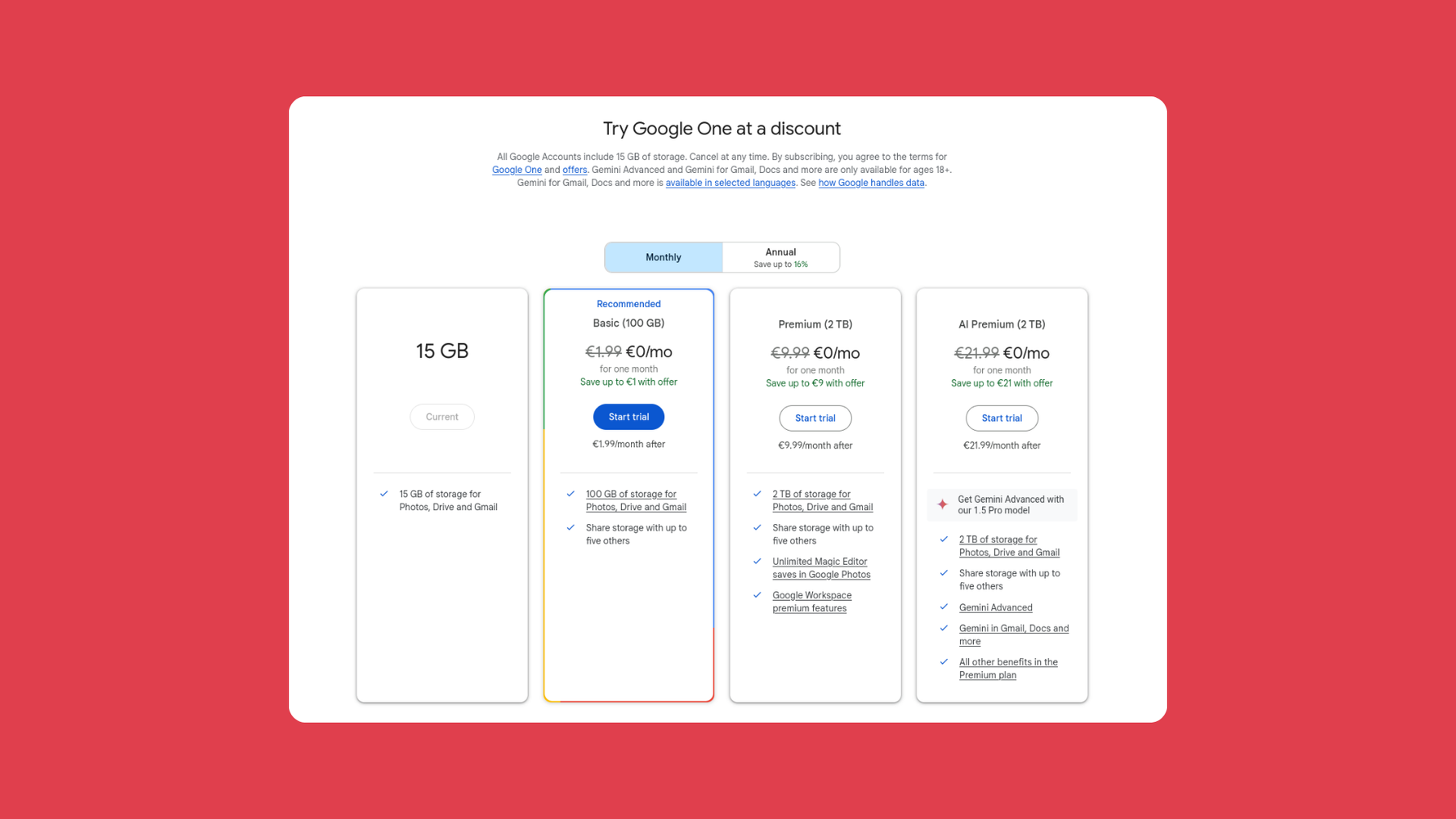

Gmail’s free plan, offers good storage space and an easy-to-use interface for personal use. If you’d like more storage space which you can share with others you can upgrade to a Basic plan which costs 1.99 €/mth. If you’re looking to use Google Workspace Premium features you’ll need to get the Premium plan for 9.99 €/mth
Summarized: Both email providers offer generous free email accounts which are good for everyday emails, but if you’re in need of more storage space, or want to make use of each email provider’s advanced features, and tools then a paid subscription would be more suitable for your needs.
Gmail vs Outlook privacy concerns
Gmail and Outlook offer email with great features, storage, and tools for free but there’s a big catch: Gmail and Outlook are owned by the Silicon Valley big tech companies Alphabet and Microsoft which make huge revenue from data mining, and ad targeting. While Gmail and Outlook.com cost you no monetary value, they both cost you your privacy.
As big techs, neither is better nor worse than the other - they’ve both had their fair share of scandals over the years. In Europe, Gmail and Outlook have faced legal issues due to violations of the EU General Data Protection Regulation ( GDPR). These violations even led to concerns over whether Outlook must be declared illegal for German schools, and Gmail was even banned from Danish schools.
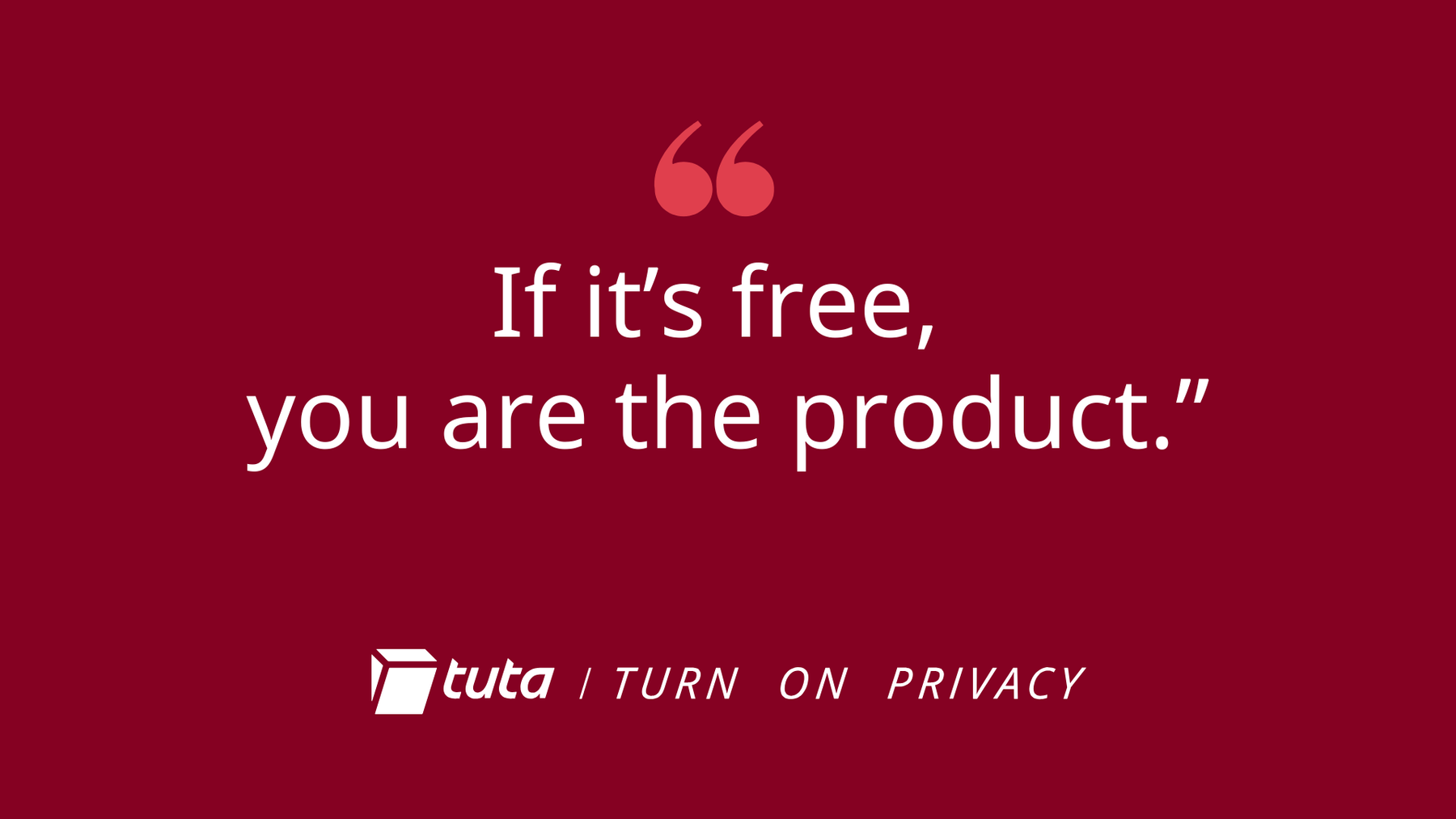

Google and Outlook offer email at the cost of your privacy.
Leaving Outlook for better security
Unfortunately, Microsoft is no stranger to getting hacked. In 2023, China hacked Microsoft’s email servers, and before that Microsoft suffered a severe database hack. In 2023, Outlook released a new client that collects more data than ever before. Including your private emails and passwords which the client shares with Microsoft servers. For many, Microsoft’s endless scandals and data breaches are reasons pushing them to delete Outlook.com accounts and move their data to more secure email providers
De-googling for more privacy
A lack of privacy and unethical data practices are a major reason many people are De-Googling. They are not only deleting their Gmail accounts, but ditching all Google products entirely. Considering how much data Google collects, it’s invasive tracking methods and everything it knows about you - it’s no surprise people are proactively protecting their privacy, and opting for privacy-focused alternatives like Tuta Mail.
Which is better: Gmail or Outlook?
Deciding if Gmail or Outlook is the best email service all comes down to your personal preference and needs. Outlook and Gmail both come with their list of pros and cons as mentioned above. In summary, Outlook and Gmail both offer a free email account with 15 GB of free storage and some different functions and tools.
Outlook has advanced search functions and great organization abilities but its interface is a little less user-friendly, cluttered, and crowded compared to Gmail. If you want to make the most of Outlook and its functions, getting a paid subscription to Microsoft 365 will allow you to download the desktop apps and your Outlook mail will integrate effortlessly with all the Microsoft tools and services.
Gmail is known for its user-friendly interface, which for many ranks better than Outlook’s interface. Gmail has great spam filtering and advanced features that users with a free account can take full advantage of. If you want to use all of Google’s tools and features, and decide to get a Google Workspace account, it integrates well with Gmail. In addition, Google Workspace offers more paid plans, giving you a wider variety to choose from.
Gmail and Outlook not doing it for you? Tuta Mail might be the solution.
Maybe you’ve read this article, you know what Gmail and Outlook offer and you’re not convinced either is best for you?… We couldn’t agree more. After all, Gmail and Outlook are full of ads and you’re giving away your privacy for a ‘free’ email account!
Luckily, we have a better alternative - Tuta Mail. Tuta Mail is best known for being private and secure as well as its focus on open source. Tuta Mail is available on all platforms, has free desktop client for Linux, macOS and Windows as well as free mobile apps for Android and iOS. This makes it the perfect solution for those wanting privacy and convenience integrated into a user-friendly interface.
In contrast to email providers like Gmail and Outlook, with Tuta Mail, the entire mailbox is end-to-end encrypted – by default. Your calendar, address book, and emails are so secure that not even we at Tuta can read your data or snoop about in your mailbox. When sending an email automatic encryption works on all mobile and desktop devices allowing you the freedom of privacy and convenience on your chosen device! With Tuta you are given top privacy, security and free open source clients for all your devices – its part of Tuta’s philosophy.
Tuta is committed to sustainability! All user data is stored on Tuta’s owned secure servers based in Germany, fully GDPR-compliant, which are powered by 100% renewable energy.
Tuta Mail gives you an ehtical, free email provider with top privacy, security, zero tracking and zero ads!

